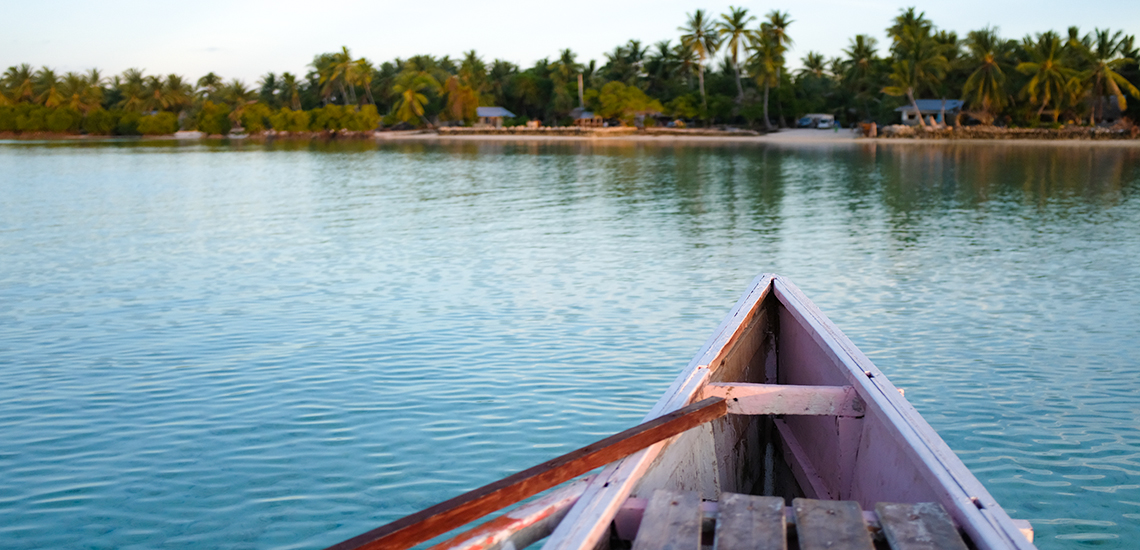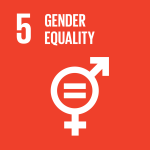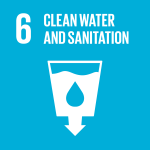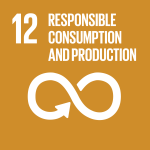
The Republic of Kiribati is a small island state with 33 low-lying and narrow atolls dispersed over 3.5 million km² in the Central Pacific Ocean and a population of approximately 110,000 people.
Climate change and climate-induced disasters are projected to exacerbate the vulnerability of Kiribati’s people by causing more frequent inundations leading to damage of coastal infrastructure and exacerbating already problematic access to clean water and food.
Despite an existing strong policy framework and previous efforts, several barriers exist that prevent Kiribati from achieving its adaptation goals.
Implemented with the Office of the President (Te Beretitenti), this project aims to benefit 17,500 people (49% women) on the five pilot islands of Makin, North Tarawa, Kuria, Onotoa and Kiritimati.
It is expected to contribute to several Sustainable Development Goals: SDG5 Gender Equality, SDG6 Clean Water and Sanitation, SDG12 Responsible Consumption and Production and SDG13 Climate Action.
- Community
- National
- Country Office
- National Governments
- United Nations Development Programme (UNDP)
17,500 people (49% women) on the islands of Makin, North Tarawa, Kuria, Onotoa and Kiritimati
- United Nations Development Programme (UNDP)
- Government of Kiribati
Expected outcomes
- Component 1: National and sectoral policies strengthened through enhanced institutions and knowledge
- Component 2: Island level climate change resilient planning and institutional capacity development in 5 pilot islands
- Component 3: Whole-of-Islands (WoI)-implementation of water, food security and infrastructure adaptation measures
- Component 4: Enhanced knowledge management and communication strategies
- Image

- Image

- Image

- Image

Background: Projected impacts of climate change on coastal infrastructure, water and food security in Kiribati
Climate change and climate-induced disasters are projected to cause more frequent inundations leading to damage of coastal infrastructure/ community assets and exacerbating the already problematic access to clean water and food.
Geographically, Kiribati’s narrow land masses and low-lying geography (in average 1-3 meters above mean sea level other than Banaba Island) results in almost the entire population being prone to flooding from storm surges and sea-level rise.
The low-lying atoll islands are already experiencing inundation leading to a loss of land, buildings and infrastructure. Mean sea level is projected to continue to rise (very high confidence) by approximately 5-15 cm by 2030 and 20-60 cm by 2090 under the higher emissions scenario.
Sea-level rise combined with natural year-to-year changes will increase the impact of storm surges and coastal flooding. This will lead to increased risks of damage to coastal homes, community infrastructure (community halls, schools, churches) and critical infrastructure, such as health clinics and roads. Further, increasing damage and interruption to roads, causeways and bridges, might lead to isolation of communities.
Sea-level rise also results in greater wave overtopping risk, and when marine flooding occurs, saltwater infiltrates down into the freshwater aquifer causing contamination. This risk will increase with sea-level rise and increased flooding and impact both water security and food security from agricultural production.
With limited groundwater reservoirs, access to clean water and sanitation is already a serious problem in Kiribati, impacting health and food security. Agricultural crop production can be expected to be increasingly affected by saltwater inundation, more extreme weather patterns, pests and diseases. This negative impact on food security is further exacerbated by the projected impact on coastal subsistence fisheries, affecting the main stable food source and livelihood.
Barriers and challenges
While Kiribati has a strong policy framework around climate adaptation – with adaptation and disaster risk management recognized as national priorities within the Kiribati Development Plan and Kiribati’s 20-year Vision (KV20), and a national Climate Change Policy and Joint Implementation Plan for Climate Change and Disaster Risk Management 2014-2023 – several barriers exist that prevent Kiribati from achieving its objectives, including:
- Limited integration of CCA&DRM in national and sub-national development plans and frameworks;
- Insufficient institutional coordination at national, sectoral and sub-national levels;
- Limited technical and institutional capacities at national and sub-national levels;
- Weak data management, monitoring and knowledge management (due in part to challenges in gathering and analysing data from dispersed and remote island communities without effective communication and information management systems); and
- Limited community knowledge and adaptive solutions for CCA&DRM at outer island level.
Project interventions
This project will address the exacerbation of climate change on coastal infrastructure, water security and food security by increasing community resilience to the impacts of climate change, climate variability and disasters and building capacities at island and national levels, with benefits extended to household level and in community institutions/facilities such as schools, health clinics, community halls, agricultural nurseries, and Islands Councils.
It is expected to deliver adaptation benefits to the entire population on the five islands of Makin, North Tarawa, Kuria, Onotoa and Kiritimati, estimated at approximately 17,500 people (49% women).
The Project will address key challenges and vulnerabilities to climate change through four interrelated components:
- Component 1: National and sectoral policies strengthened through enhanced institutions and knowledge
- Component 2: Island level climate change resilient planning and institutional capacity development in 5 pilot islands
- Component 3: WoI-implementation of water, food security and infrastructure adaptation measures
- Component 4: Enhanced knowledge management and communication strategies
It is expected to support progress towards the following Sustainable Development Goals:
- SDG 13: Take urgent action to combat climate change and its impacts;
- SDG 5: Achieve gender equality and empower women, by ensuring women’s equitable participation in Project planning and implementation and by actively monitoring gender equity and social inclusion outcomes.
- SDG 6: Ensure availability and sustainable management of water and sanitation for all;
- SDG 12: Achieve food security and improved nutrition and promote sustainable agriculture
Key implementing partners
- Office of Te Beretitenti (OB – Office of the President) - CC&DM division
- Kiribati National Expert Group on Climate Change and Disaster Risk Management
- Ministry of Internal Affairs
- Ministry of Finance and Economic Development
- Ministry of Environment, Lands and Agriculture Development
- Ministry for Infrastructure and Sustainable Energy
- Ministry for Women, Youth and Social Affairs
- Ministry of Fisheries and Marine Resources Development
- Ministry of Commerce, Industry and Cooperatives
- Ministry of Line and Phoenix Islands Development
- Ministry of Justice
- Ministry of Information, Transport, Tourism and Communication Development (MITTCD)
- Parliament Select Committee on Climate Change
- Island Councils
- Extension officers
- Village Elders and Leaders
- Women and Youth
- Community-based groups
- KiLGA (Kiribati Local Government Association)
- NGO’s
Component 1: National and sectoral policies strengthened through enhanced institutions and knowledge
Outcome 1 Capacities of national government institutions and personnel is strengthened on mainstreaming climate and disaster risks, supporting the operationalization of the Kiribati Joint Implementation Plan for Climate Change and Disaster Risk Management 2014-2023 (KJIP)
Output 1.1.1 National and sectoral level policy, planning and legal frameworks revised or developed, integrating climate change and disaster risks
Output 1.1.2 National, sectoral and island level monitoring and evaluation (M&E) processes, related data-gathering and communication systems enhanced and adjusted to support KJIP implementation
Output 1.1.3 Coordination mechanism for the Kiribati Joint Implementation Plan for Climate Change and Disaster Risk Management 2014-2023 (KJIP) enhanced
Output 1.1.4 Tools and mechanisms to develop, stock, and share data, knowledge, and information on climate change and disaster risks enhanced at the national level
Component 2: Island level climate change resilient planning and institutional capacity development
Outcome 2 Capacity of island administrations enhanced to plan for and monitor climate change adaptation processes in a Whole of Islands (WoI) approach
Output 2.1.1 Island and community level vulnerability and adaptation (V&A) assessments revised and/or developed for 5 targeted islands
Output 2.1.2 Island Council Strategic Plans developed/reviewed and complemented with Whole of Islands (WoI)-implementation and investments plans in 5 targeted islands
Output 2.1.3 Tools and mechanisms to develop, stock and share data, knowledge, and information on climate change and disaster risk enhanced at island level to strengthen information, communication and early warning mechanisms
Output 2.1.4 I-Kiribati population on 5 targeted islands receives awareness and technical training on climate change adaptation and disaster risk management
Component 3: Whole of Island implementation of water, food security and infrastructure adaptation measures
Outcome 3 Community capacities enhanced to adapt to climate induced risks to food and water security and community assets
Output 3.1.1 Climate-resilient agriculture and livestock practices (including supply, production and processing/storage aspects) are introduced in 5 outer islands
Output 3.1.2 Water security improved in 5 targeted project islands
Output 3.1.3 Shoreline protection and climate proofing of infrastructure measures implemented at 5 additional islands and communities
Component 4: Knowledge management and communication strategies
Outcome 4 Whole of Islands (WoI)-approach promoted through effective knowledge management and communication strategies
4.1.1 Whole of Islands (WoI)-communication, engagement and coordination strengthened at national, island and community levels
4.1.2 Whole of Islands (WoI)-lessons learned captured and shared with national and regional stakeholders
Local Project Appraisal Committee (LPAC) Meeting TBC
Inception workshop TBC
The project results, corresponding indicators and mid-term and end-of-project targets in the project results framework will be monitored annually and evaluated periodically during project implementation.
Monitoring and evaluation will be undertaken in compliance with UNDP requirements as outlined in UNDP’s Programme and Operations Policies and Procedures (POPP) and UNDP Evaluation Policy, with the UNDP Country Office responsible for ensuring full compliance with all UNDP project monitoring, quality assurance, risk management, and evaluation requirements.
Additional mandatory GEF-specific M&E requirements will be undertaken in accordance with the GEF Monitoring Policy and the GEF Evaluation Policy and other relevant GEF policies.
The project will complete an inception workshop report (within 60 days of project CEO endorsement); annual project implementation reports; and ongoing monitoring of core indicators.
An independent mid-term review will be conducted and made publicly available in English and will be posted on UNDP’s Evaulation Resource Centre ERC.
An independent terminal evaluation will take place upon completion of all major project outputs and activities, to be made publicly available in English.
The project will use the Global Environment Facility’s LDCF/SCCF Adaptation Monitoring and Assessment Tool to monitor global environmental benefits. The results will be submitted to the GEF along with the completed mid-term review and terminal evaluation.
The UNDP Country Office will retain all M&E records for this project for up to seven years after project financial closure to support ex-post evaluations undertaken by the UNDP Independent Evaluation Office and/or the GEF Independent Evaluation Office.
Results and learnings from the project will be disseminated within and beyond the project through existing information sharing networks and forums.
M&E Oversight and Monitoring Responsibilities
The Project Manager is responsible for day-to-day project management and regular monitoring of project results and risks.
The Project Board will take corrective action as needed to ensure the project achieves the desired results. The Project Board will hold project reviews to assess the performance of the project and appraise the Annual Work Plan for the following year. In the project’s final year, the Project Board will hold an end-of-project review to capture lessons learned and discuss opportunities for scaling up and to highlight project results and lessons learned with relevant audiences.
The Implementing Partner is responsible for providing all required information and data necessary for timely, comprehensive and evidence-based project reporting, including results and financial data, as necessary. The Implementing Partner will strive to ensure project-level M&E is undertaken by national institutes and is aligned with national systems so that the data used and generated by the project supports national systems.
The UNDP Country Office will support the Project Manager as needed, including through annual supervision missions.
- UNDPAzza AishathRegional Technical Specialist - Climate Change Adaptation
